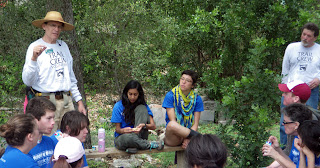Bobcat Build students tackle projects at Prospect Park
In the third year of concerted effort Greenbelt Alliance members led 25 Texas State students on a variety of projects aimed at improving water conservation and recreation at Prospect Park March 23
 |
| Students clear ligustrum from the karst area |
. Projects included improving the view sheds at both Inge’s and Metz benches that command vistas of the park. Water bars to shed heavy rains off the trail were installed on Limbo Loop and at the trail head on Prospect Street. Five new Anacua trees were planted along Virgil’s trail as it enters the meadow. One of the most visible projects involved cutting and removing ligustrum, an invasive small tree that shuts out all other plants and is non-native. This was followed with a team that seeded native grasses and wildflowers.
The tasking, organization, tool issue and priority listing were accomplished by Todd Derkacz and Charles O’Neil.
Bobcat Build student volunteers worked at Purgatory Creek natural area and Ringtail Ridge in previous years. SMGA has concentrated student efforts during the last three years on the thirty plus acres of Prospect Park.
As is true every year there were more tasks than available volunteers and supervisors.
Trail improvements remained a priority and several re-routes and installation of water bars were critical for the continued erosion control of the natural area. Mark and Ben Taylor led teams working on these critical tasks. Not surprising these were among the most labor intensive jobs requiring moving crushed limestone in heavy wheelbarrows to the specific sites. Paul Murray headed up the team shoveling and tamping down the limestone that would divert future heavy rains off trail and into the soil.
The project requiring the most volunteers was removing the ligustrum. While this has been an on-going project there remains much still to do but a noticeable improvement has been accomplished. Donna Browning and Richard McBride chainsawed the multi-trunked trees before the students arrived. Melani Howard and Mike Baugh handled the task of carefully applying herbicide to the cut stumps.
Ligustrum or ligustrum lucidum spreads easily and is very hardy in the Hill Country soils. Over time it crowds out the native plants and diverts rainwater from entering the aquifer through the karst features prominent along Virgil’s trail. Several SMGA members including Kenny Skrobanek worked with the students using lopers to cut the downed trees into smaller pieces and spreading them around the ground.
 |
| Todd Derkacz talks after lunch |
Jo Ellen Korthals lead a group of students in seeding the disturbed bare ground with either native Texas grasses or wildflowers depending on location and germination probability. This is the positive side of habitat restoration to the negative chore of invasive removal.
Restoration from former ranch land to a more native Texas landscape is one of the goals behind water conservation, recreation and connectivity. Tree planting that will eventually provide shade along the trail was included in the task list. Five anacua trees were planted and a Mexican plum. Previously planted bois d’arc trees and a bur oak were all mulched and watered.
The success of many of these projects become evident years in the future but the erosion control efforts are tested with the next big rainfall. The students and SMGA members enjoy the natural areas and want everyone to share in the benefits.
–LJ

